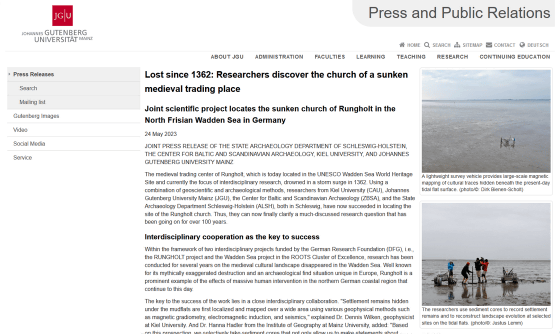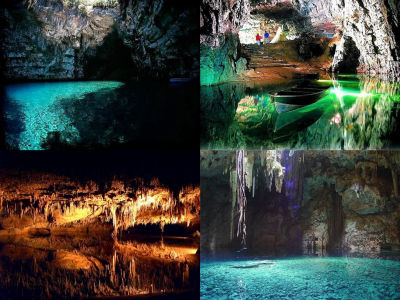The Great Church of Langholt, a medieval European city that is said to have been ``swallowed in the flood by God's punishment'' is discovered from the bottom of the tidal flat

Lost since 1362: Researchers discover the church of a sunken medieval trading place | Press and Public Relations
https://press.uni-mainz.de/lost-since-1362-researchers-discover-the-church-of-a-sunken-medieval-trading-place/

Impressive Medieval Church found at Sunken Rungholt — Medieval Histories
https://www.medieval.eu/impressive-medieval-church-found-at-sunken-runholt
Archaeologists chart secrets of 'the German Atlantis'
https://www.thetimes.co.uk/article/remains-of-lost-city-of-runholt-charted-for-first-time-x3p6ww8m2
Langholt, a city of the Duchy of Schleswig that existed from the 11th century to the 19th century in the southern part of the Jutland peninsula, is said to have prospered in the trade of the Wadden Sea , which extends from the western part of the Netherlands to Denmark.
According to folklore, the inhabitants of Langholt committed crimes such as drinking, disbelief, and showing off wealth, and lived an immoral life. Such Langholt received 'God's punishment' and it seems that he sank to the bottom of the sea due to the great flood that occurred in January 1362.
This great flood was a real thing called ' Saint Marcellus' Great Flood ', but since most of the documents that mention Langholt are from the 16th century or later, there is also a theory that Langholt is a legendary existence. there was. However, in recent excavations, various remains have been discovered, and it has been confirmed that Langholt, which was also called 'Atlantis in the North Sea', was a real city.
Langholt existed in the vicinity of a small island called Sutfahl in the state of Schleswig-Holstein, which borders Denmark at the northernmost point of Germany. A vast tidal flat spreads over the modern surrounding area, and it is believed that the surrounding cities and villages were frequently damaged by floods.

by Dirk Bienen-Scholt
Research teams

by Dirk Bienen-Scholt
From previous surveys, Langholt's population
In a new survey in May 2023, 54 terps with a length of 2 km were discovered around Sutofahl. One of the terps is believed to be the foundation of a church measuring 600 square meters, measuring 40 meters long and 15 meters wide. I have joined the ranks,” he said.

by Dirk Bienen-Scholt
In addition, the remains of Langholt are threatened by erosion, and scientists argue that it is necessary to intensify exploration of the submerged cultural landscape. Dr Hannah Hadler of the Institute of Geography at the University of Mainz says, 'In the vicinity of Sutfahl and on other tidal flats, the remains of medieval settlements have already been so heavily eroded that they are often only discreetly detectable. It is also noticeable in the surrounding area, and there is an urgent need to strengthen the investigation here.'
Related Posts:
in Note, Posted by log1h_ik







